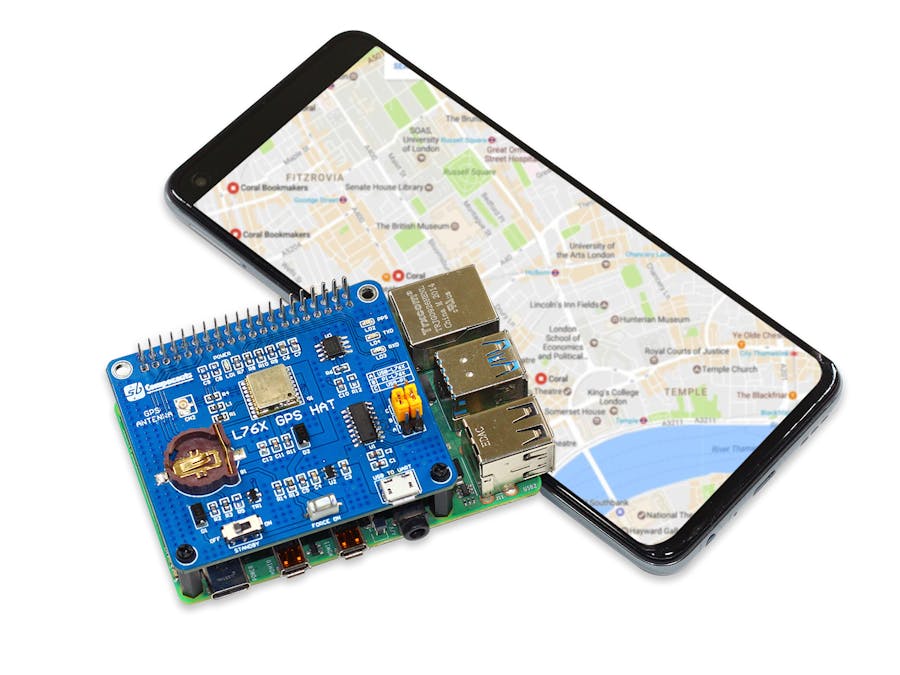Although GPS is a feature of every smartphone, a Raspberry Pi GPS module may make the Pi a GPS receiver. Many outdoor applications, especially ones that move, greatly benefit from the precise position (Car-PC, weather balloon, etc.). For mobility, a battery pack or a USB power bank is utilized.
GPS, BDS, and QZSS are all included in the L76X Raspberry Pi Multi-GNSS HAT. On your Raspberry Pi, turning on the global location is a straightforward task.
Before code run, check whether PPS led is blinking or not, it takes time approx 10 to 20 sec, and place anteena outside the house for better connection
Device Features- Supports Multi-GNSS systems: GPS, BDS, and QZSS
- UART communication baudrate: 4800~115200bps and 9600bps is default
- Four LED's for indicating the module working status
- UART selection jumper wire(A, B, and C)
- Onboard battery holder
- Protocols- NMEA 0183, PMTK
- Operating current: 13mA
- Power supply voltage: 5V / 3.3V
- Operating temperature: -40℃ to 85℃
A - USB-L76X module ( Using USB TO UART, control the L76X)
B - PI - L76X module (control the L76X through Raspberry Pi)
C - USB -PI ( access Raspberry Pi through USB TO UART)
2. Standby SwitchThe Standby switch is used to toggle between Standby and Working modes. The power consumption of the module in standby mode is quite low. It disables satellite navigation and search.
3. Backup Mode ON Button ( Force ON Button)To exit Backup mode, press the FORCE ON button.
4. Battery HolderFor maintaining ephemeris data and hot starts, there is an onboard battery holder that supports the ML1220 battery.
5. Indicators:a) RXD/TXD: UART RX/TX indicator
b) PPS: GPS status indicator (if your PPS light is blinking it means your module is receiving GPS signal)
c) PWR: power indicator of HAT
NMEA-FormatThis protocol is based on the international standard for maritime navigation and radio communication, equipment and systems and digital interfaces (IEC 61161-1). This standard adopted the de-facto standards for interfacing marine electronic devices, known as NMEA 0183. The data is transmitted in sentences of variable length with a specified sentence structure.
For eg- (OUTPUT)
$GNGGA, 185833.80, 4808.7402397, N, 01133.9325039, E, 5, 15, 1.1, 470.50, M, 45.65, M,, *75
$GNVTG, 112.99, T, 109.99, M, 0.15, N, 0.08, K, A*3B
$GNGSA, 2, M, 06, 12, 15, 17, 19, 24, 25, 32, 1.34, 0.96, 0.93*1D
Sentence structure- Address field
- Data fields
- Checksum field
- Terminating field
- All sentences contain only ASCII characters
- The maximum length of a sentence is 82 characters
- All fields are separated by delimiters
The address field starts with “$” followed by the talker ID and a sentence identifier. The used talker IDs are:
- GP for GPS-only solutions
- GL for GLONASS-only solutions
- GN for multi GNSS solutions
- GGA – Global Positioning System Fix Data
- VTG – Course over Ground and Ground Speed
- GSA – GNSS DOP and Active Satellites
- GSV – GNSS Satellites in View
- RMC – Recommended Minimum Specific GNSS Data
Data fields must always be separated by “, ”. They can contain alpha, numeric and alphanumeric values all coded in ASCII characters. The length of a data field can be constant, variable or can contain a fixed and variable portion. This differs for each sentence.
Checksum fieldThe Checksum field starts with “” followed by the checksum of the sentence. The Checksum is generated with a bitwise exclusive OR of all fields including the “, ” delimiters, between but not including the “$” and the “” characters. The hexadecimal value of the checksum is then converted to two ASCII characters.
Terminating fieldThe terminating sequence contains the two ASCII characters and without any delimiter.
Satellite NumberingGPS: 1-32
GLONASS: 33-96
Codegps_lib.py - library of GPS
gps_raw_data.py - Run this file to receive GPS raw data
google_map.py - Run this file to show your location on the google map
main.py - Run the file to know the location, number of satellites, altitude, speed, etc













Comments
Please log in or sign up to comment.